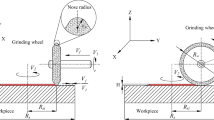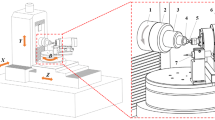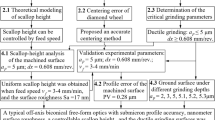Abstract
Free-form surfaces have been widely used in complex optical devices to improve the functional performance of imaging and illumination quality and reduce sizes. Ultra-precision grinding is a kind of ultra-precision machining technology for fabricating free-form surfaces with high form accuracy and good surface finish. However, the complexity and variation of curvature of the free-form surface impose a lot of challenges to make the process more predictable. Tool path as a critical factor directly determines the form error and surface quality in ultra-precision grinding of free-form surfaces. In conventional tool path planning, the constant angle method is widely used in machining free-form surfaces, which resulted in non-uniform scallop-height and degraded surface quality of the machined surfaces. In this paper, a theoretical scallop-height model is developed to relate the residual height and diverse curvature radius. Hence, a novel tool-path generation method is developed to achieve uniform scallop-height in ultra-precision grinding of free-form surfaces. Moreover, the iterative closest-point matching method, which is a well-known algorithm to register two surfaces, is exploited to make the two surfaces match closely through rotation and translation. The deviation of corresponding points between the theoretical and the measured surfaces is determined. Hence, an optimized tool-path generator is developed that is experimentally verified through a series of grinding experiments conducted on annular sinusoidal surface and single sinusoidal surface, which allows the realization of the achievement of uniform scallop-height in ultra-precision grinding of free-form surfaces.











Similar content being viewed by others
Abbreviations
- N s :
-
Rotational speed of grinding wheel spindle (mm)
- N w :
-
Rotational speed of workpiece spindle (rpm)
- R s :
-
Wheel radius (mm)
- r s :
-
Nose radius of the grinding wheel (mm)
- V f :
-
Feed speed (mm/min)
- R :
-
Rotation transformation matrix
- R w :
-
Workpiece radius (mm)
- S :
-
Tool path interval (mm)
- ρ w :
-
Curvature radius of workpiece surface (mm)
- R t :
-
Scallop height (mm)
- H :
-
Depth of cut (μm)
- Q ij :
-
Points on the measured surface
- A :
-
Amplitude of sinusoidal surface (mm)
- φ :
-
Phase angle (rad)
- λ :
-
Wave length of sinusoidal surface (mm)
- M :
-
Machining transformation matrix
- T :
-
Translation matrix
- P ij :
-
Points on the measured surface
References
Brinksmeier E, Glabe R, Flucke C (2008) Manufacturing of molds for replication of micro cube corner retroreflectors. Prod Eng 2(1):33–38
Lazoglu I, Manav C, Murtezaoglu Y (2009) Tool path optimization for free form surface machining. CIRP Ann Manuf Technol 58(1):101–104
Lasemi A, Xue DY, Gu PH (2010) Recent development in CNC machining of freeform surfaces: a state-of-the-art review. Comput Aided Des 42(7):641–654
Lasemi A, Xue DY, Gu PH (2014) Tool path re-planning in free-form surface machining for compensation of process-related errors. Int J Prod Res 52(20):5913–5931
Fang FZ, Zhang XD, Weckenmann A et al (2013) Manufacturing and measurement of freeform optics. CIRP Ann Manuf Technol 62(2):823–846
Brinksmeier E, Mutlugünes Y, Klocke FJC et al (2010) Ultra-precision grinding. CIRP Ann Manuf Technol 59(2):652–671
Li H, Remus TF, Feng HY (2007) An improved tool path discretization method for five-axis sculptured surface machining. Int J Adv Manuf Technol 33(9–10):994–1000
Lin Z, Fu J, Shen H et al (2014) A generic uniform scallop tool path generation method for five-axis machining of freeform surface. Comput Aided Des 56:120–132
Gong H, Wang Y, Song L et al (2015) Spiral tool path generation for diamond turning optical freeform surfaces of quasi-revolution. Comput Aided Des 59:15–22
Yu DP, Gan SW, Wong YS et al (2012) Optimized tool path generation for fast tool servo diamond turning of micro-structured surfaces. Int J Adv Manuf Technol 63(9):1137–1152
Kwok TC, Cheung CF, Kong LB et al (2010) Analysis of surface generation in ultra-precision machining with a fast tool servo. Proc Inst Mech Eng Part B J Eng Manuf 224(9):1351–1367
Yu DP, Hong GS, Wong YS (2012) Profile error compensation in fast tool servo diamond turning of micro-structured surfaces. Int J Mach Tools Manuf 52(1):13–23
Kong LB, Cheung CF (2012) Modeling and characterization of surface generation in fast tool servo machining of microlens arrays. Comput Ind Eng 63(4):957–970
Zhou M, Zhang HJ, Chen SJ (2010) Study on diamond cutting of nonrationally symmetric microstructured surfaces with fast tool servo. Mater Manuf Process 25(6):488–494
Acknowledgements
This work was supported by a Ph.D. studentship (Project Account Code: RU3K) from The Hong Kong Polytechnic University and a grant from the Innovation and Technology Commission (ITC) (Project No. GHP/031/13SZ) of the Government of the Hong Kong Special Administrative Region. This research work was also supported by the State Key Basic Research and Development Program, China (973 Program, Grant No. 2011CB 013202) and Guangdong Provincial Department of Science and Technology, Guangdong, P. R. China for The Introduction of Innovative R&D Team Program of Guangdong Province (Project No.: 201001G0104781202).
Author information
Authors and Affiliations
Corresponding author
Rights and permissions
About this article
Cite this article
Chen, S., Cheung, C.F., Zhang, F. et al. Optimization of Tool Path for Uniform Scallop-Height in Ultra-precision Grinding of Free-form Surfaces. Nanomanuf Metrol 2, 215–224 (2019). https://doi.org/10.1007/s41871-019-00048-0
Received:
Revised:
Accepted:
Published:
Issue Date:
DOI: https://doi.org/10.1007/s41871-019-00048-0




